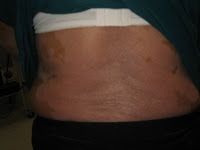
I saw this patient in the Medical clinic yesterday.
He is a 45 years old man with Follicular lymphoma who completed chemotherapy CHOP in 2006 with no B symptoms and no enlarged lymph nodes.
If you see him, you would think that he has jaundice. But, his sclera does not show that .
Further history reveals that he has been taking 3 carrots daily since after the chemo as was told to be good from his friends. Yup ! Carotenaemia.
What causes carotenaemia?
Excessive intake of carrots, and/or other yellow and green vegetables and citrus fruits are the usual cause of
carotenaemia (American spelling carotenemia). Carotene is the chief precursor of Vitamin A and is converted to
this in the mucosal cells that line the small intestine. Pancreatic lipase enzymes, bile salts, fat, and thyroid
hormone aid conversion and absorption. Thus carotenaemia is more likely in some diseases such as liver disease,
hypothyroidism and diabetes mellitus where this is impaired. In rare cases, a genetic defect in carotene
metabolism may also be a cause of carotenaemia, without requiring excessive intake of carotene.
Who gets carotenaemia?
Carotenaemia can occur at any age but is most common in young children fed large amounts of commercial
infant food preparations. These foods often contain carrots, pumpkin, squash, spinach and sweet potato, all of
which are high in carotene. Cooking, mashing and pureeing these foods make carotene more available for
absorption. Carotenaemia has also been found in vegetarians or food faddists who over-indulge in carrots and
oranges.
What are the clinical features?
Carotenaemia is characterised by yellow discolouration of the skin, particularly in areas where the horny layer is
thickened such as the soles and palms. It is also most evident on areas where subcutaneous fat is abundant. The
sclera (white outer coating of the eyeball) and mucous membranes (eyes, mouth, nostrils etc) are unaffected. The
presence of yellowing of the sclera usually means there is increased circulating bilirubin and is known as jaundice.





























